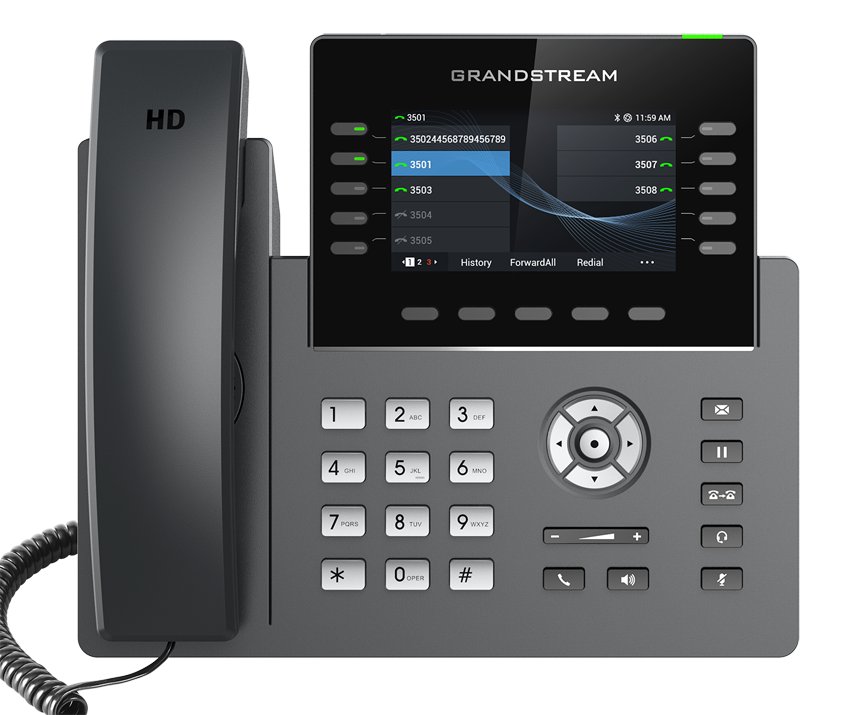
In an era where agile communication is vital, how can businesses harness customizable telephony solutions to revolutionize their networks? Grandstream’s innovative IP phones, like the GRP series, offer carrier-grade reliability designed for rapid deployment and seamless management through centralized platforms such as GDMS. These systems transform traditional communication, enabling dynamic call routing, personalized greetings, and tight integration with CRM and collaboration tools. As organizations expand, their need for flexible, secure, and scalable solutions becomes urgent—yet many still rely on outdated landlines or inflexible systems. By adopting cloud-managed VoIP technology, companies can reduce costs, boost responsiveness, and enhance customer experiences. But is your network prepared to support this new wave of intelligent, adaptable communication? With Grandstream’s cutting-edge devices and management tools, the future of unified, customizable telephony is within reach—ready to elevate your business success?
Enhance Your Business Communications with FiberConX’s VoIP Solutions in Canada
Looking for reliable VoIP and IP business phone services in Canada? FiberConX Communications offers advanced features like voicemail, IVR, Ring Groups, and voicemail-to-mail, ensuring seamless communication for your business. Our solutions are designed to improve efficiency and customer experience. One of the popular devices we support is the Grandstream GXP2170, known for its robust performance and user-friendly interface. Whether you’re upgrading your existing system or building a new communication infrastructure, FiberConX has the expertise to tailor solutions to your needs. Contact us today at 1.800.961.6856 or Sales@FiberConX.com to learn more about how we can help elevate your business communications.

Unlocking Business Success with Customizable Telephony Solutions
In today’s fast-moving business landscape, clear and adaptable communication has become more than just a convenience—it’s a competitive necessity. Companies that can swiftly tailor their phone systems to meet evolving demands gain a significant edge, enhancing internal workflows and delivering better customer experiences. This is the core advantage of customizable telephony solutions: they empower organizations to design communication setups that fit their unique operations, rather than forcing them into rigid, one-size-fits-all systems. Such flexibility streamlines processes, minimizes frustration, and boosts overall productivity.
As businesses expand and shift, their communication needs grow more complex. Traditional landlines or basic phone systems often fall short, offering limited options for call routing, personalization, or integration with other tools. Modern solutions—especially those built on cloud platforms—allow for seamless adjustments. Whether it’s adding new users, reconfiguring call flows, or integrating with customer management systems, these systems can be updated quickly and easily, without lengthy downtime or technical headaches. This agility helps organizations stay responsive and competitive in dynamic markets.
Customizable telephony extends beyond call routing. It creates a cohesive experience for both employees and customers through features like personalized greetings, role-based call handling, and intuitive user interfaces. These enhancements make interactions more engaging and efficient, allowing staff to spend less time navigating menus and more time focusing on meaningful conversations. Customers, in turn, enjoy a more consistent, professional experience that strengthens brand perception and builds trust. The result is a communication environment that feels tailored to the needs of both sides.
The real power of these systems lies in their ability to integrate with other digital tools. Modern telephony solutions support seamless connections with CRM systems, messaging platforms, and collaboration apps, creating a unified communication ecosystem. This integration accelerates decision-making, improves responsiveness, and offers richer data insights, enabling organizations to refine their strategies continuously. As technology advances, having a flexible, adaptable communication infrastructure becomes essential for staying ahead.
Furthermore, the capacity to adapt quickly as organizations grow or shift is what makes customizable telephony solutions truly valuable. Whether expanding to new locations or launching remote teams, cloud-managed systems ensure deployment remains straightforward and efficient. Centralized control panels allow for simple device configuration, feature updates, and security management across multiple sites—all from a single interface. This level of control keeps communication networks resilient, scalable, and ready to support future growth and innovation.
In essence, customizable telephony solutions transform how organizations communicate, offering a blend of flexibility, efficiency, and strategic advantage. They turn traditional, static systems into dynamic assets that evolve with the business, facilitating smoother operations and stronger customer relationships. For companies looking to harness the full potential of their communication infrastructure, embracing these tailored solutions isn’t just smart—it’s necessary for long-term success.

Foundations of Telephony: From Landlines to Cloud-Driven Networks
Telephony has undergone a dramatic transformation since its inception, evolving from simple landline connections into complex, digital communication networks that power today’s global business landscape. Originally, landlines provided a straightforward way for people to connect, but their limitations quickly became apparent as organizations needed more flexible, feature-rich solutions to keep pace with rapid growth and changing demands. These early systems were tied to physical infrastructure, making scaling and modifications difficult and costly. As a result, businesses often found themselves constrained by the rigidity of traditional landline setups, which couldn’t easily support advanced call management or integration with other communication channels.
The advent of digital technology marked a significant turning point, with Private Branch Exchange (PBX) systems introducing more sophisticated call handling capabilities. Digital PBXs allowed for features like call transfer, voicemail, and auto-attendants, which added a layer of flexibility previously unavailable. These systems also supported better call routing and conference calling, creating a more connected environment within organizations. While they represented a step forward, digital PBXs still relied heavily on physical hardware and dedicated infrastructure, which limited their ability to adapt quickly to evolving needs or support remote work configurations.
The real revolution in telephony came with Voice over Internet Protocol (VoIP), a technology that transmits voice as digital data over the internet. VoIP drastically reduced communication costs and opened new doors for scalability and flexibility. Instead of dedicated phone lines, businesses could leverage their existing internet connections to make and receive calls. This shift not only lowered expenses but also simplified the process of adding new lines or expanding to new locations. VoIP systems support a range of advanced features, including mobility, integration with digital tools, and remote device management, making them ideal for organizations seeking agility.
Underlying VoIP’s success is a robust network infrastructure that ensures voice data travels efficiently and securely. Key components like routers, switches, firewalls, and security protocols work together to maintain high-quality call experiences. Proper network setup is crucial because the quality of VoIP calls depends heavily on bandwidth and network stability. Companies need to evaluate their existing network capabilities to support VoIP systems effectively, ensuring that voice data isn’t compromised by latency, jitter, or packet loss. When configured correctly, a well-maintained network provides the foundation for clear, reliable communication, even with multiple simultaneous calls.
Standards like the Session Initiation Protocol (SIP) have become essential to managing VoIP communications. SIP enables devices to establish, modify, and terminate voice sessions seamlessly over the internet, supporting a flexible and scalable communication environment. These protocols facilitate interoperability among different devices and platforms, allowing organizations to build integrated, multi-channel systems. Cloud-based management platforms further enhance this flexibility by providing centralized control over devices, configurations, and updates. With these tools, organizations can deploy, troubleshoot, and maintain their telephony networks remotely, reducing operational costs and improving responsiveness.
Today’s telephony solutions are increasingly integrated with video, messaging, and collaboration tools, creating unified communication platforms that break down traditional silos. This convergence allows employees to switch effortlessly between voice, video, and text, supporting faster decision-making and more cohesive teamwork. Cloud management systems make it straightforward to incorporate new features and integrations, ensuring that communication tools evolve alongside organizational needs. This interconnected approach enhances responsiveness, improves user experience, and provides richer data insights for strategic decision-making.
As the landscape continues to evolve, security plays a vital role in safeguarding voice communications and sensitive data. Modern cloud platforms incorporate role-based access controls, encryption, and real-time monitoring to protect against cyber threats. Centralized management allows IT teams to quickly respond to vulnerabilities, deploy security patches, and monitor for suspicious activity across all devices and locations. Maintaining a secure environment is essential not only for compliance but also to preserve customer trust and protect organizational reputation. Proper security measures ensure that the benefits of flexible, cloud-enabled telephony are not overshadowed by potential risks.

Modern Telephony in Action: Embracing Cloud Platforms and Smart Devices
Many businesses today are actively transitioning to new telephony devices and cloud-based management platforms to modernize their communication infrastructure. This shift isn’t just about swapping out outdated hardware; it’s about building a flexible, scalable system that can adapt swiftly to changing organizational needs. Companies are increasingly deploying IP phones from brands like Grandstream, which support remote provisioning and centralized control through platforms such as GDMS. These tools enable IT teams to configure, monitor, and update devices from anywhere, significantly reducing the need for on-site visits and minimizing downtime. As a result, deploying new devices becomes faster and more efficient, aligning seamlessly with business growth and strategic shifts.
The appeal of cloud-managed telephony solutions is particularly strong for organizations with multiple locations. Centralized control allows for consistent configurations across all sites, simplifying troubleshooting and reducing operational complexity. This setup makes scaling operations easier—adding new users or expanding to new regions involves just a few clicks rather than extensive manual setups. For remote and hybrid teams, cloud management offers unparalleled flexibility, enabling device management from any location without compromising security or performance. These platforms also support seamless updates and security patches, ensuring systems remain current and protected without interrupting daily workflows.
Cost efficiency is a major driver behind this digital transformation. Cloud management reduces the need for extensive physical infrastructure and cuts down on labor costs associated with device deployment and maintenance. Instead of dispatching technicians for each update or repair, IT teams can perform most tasks remotely, accelerating response times and reducing operational expenses. This streamlined approach not only saves money but also allows organizations to respond swiftly to new opportunities or internal changes, maintaining a competitive edge. The ability to manage multiple devices from a single interface further prevents errors, promotes consistency, and speeds up issue resolution—boosting overall operational efficiency.
Beyond hardware and deployment, these solutions excel in customization. Modern IP phones from brands like Grandstream come with programmable features such as call routing, personalized greetings, and user-specific settings. When managed through a cloud platform, implementing these personalized communication profiles at scale becomes straightforward. Organizations can easily assign different configurations for departments, roles, or individual users, which enhances productivity and user satisfaction. This level of customization ensures that communication flows smoothly, adapting to each team’s specific workflows and requirements, thereby elevating the overall user experience.
Integration with other digital tools is another key advantage. Today’s telephony devices are designed to work seamlessly with CRM systems, messaging platforms, and collaboration tools, creating a unified communication ecosystem. Cloud management platforms simplify the process of coordinating these integrations, enabling faster decision-making and improved responsiveness. Employees can switch effortlessly between voice, video, and text channels within a cohesive platform, supporting faster collaboration and more efficient workflows. This interconnected setup not only accelerates internal processes but also enhances customer interactions, fostering stronger relationships and loyalty.
Security remains a top priority as organizations adopt cloud-managed telephony. These platforms incorporate role-based access controls, encryption, and continuous monitoring to safeguard sensitive conversations and customer data. Centralized management allows IT teams to quickly respond to vulnerabilities, deploy patches, and monitor for suspicious activity across all devices and sites. This proactive security approach minimizes risks and ensures compliance with industry standards, providing peace of mind without adding operational complexity. Managing security centrally simplifies oversight and reduces the likelihood of oversight, which is crucial in today’s threat landscape.
While the benefits are clear, transitioning to cloud-managed telephony requires careful planning. Compatibility checks ensure new devices integrate smoothly with existing network infrastructure, especially in hybrid or multi-site environments. Organizations need to evaluate their network capacity to support VoIP traffic effectively, addressing potential issues like bandwidth limitations or security protocols. Training staff on new features and workflows is also essential to maximize the value of these systems. Fortunately, vendors like Grandstream offer comprehensive support, detailed documentation, and user-friendly devices designed for ease of use. This support helps organizations navigate potential hurdles and fully realize the advantages of their new telephony solutions.
Overall, the current landscape of telephony solutions reflects a move toward smarter, cloud-enabled systems that prioritize flexibility, scalability, and ease of management. Businesses recognize that investing in these technologies offers a competitive advantage—faster deployment, personalized communication, and enhanced security. By adopting these modern solutions, organizations position themselves for sustained growth and innovation, ready to meet the evolving demands of today’s digital-first environment. With the right devices and management tools in place, they can build resilient, efficient, and customer-centric communication networks that support their broader strategic goals.
For those interested in exploring the latest in IP phone technology, learning more about Grandstream IP Phones can provide valuable insights. These devices are designed to integrate seamlessly with cloud management platforms, offering enhanced functionality and user experience. By leveraging such tools, organizations can further optimize their communication infrastructure, ensuring they stay ahead in a competitive digital landscape.


